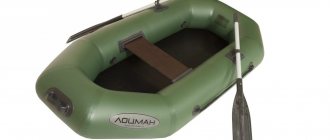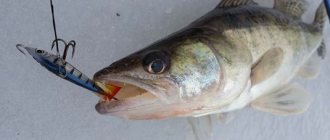Every fisherman dreams of owning a boat, but before making such a purchase, you should familiarize yourself with the rules for storing it, especially if winter comes soon. If these tips are ignored, the product will not last more than one year or even less.
Modern boats are almost never made of rubber, since polyvinyl chloride is more reliable and resistant to natural conditions. But, despite its high reliability, everyone should know how to store a PVC boat in winter.
Preparing a PVC boat for storage
If you put your boat into storage and do not prepare it beforehand, there is a risk that it will become damaged after the winter.
To prevent this from happening, it is worth considering the following recommendations from experienced fishermen:
- At the first stage, the watercraft must undergo thorough cleaning. Any dirt, including aquatic vegetation, must be removed. Also, do not forget about dirt and sand in hard-to-reach places. For cleaning it is better to use a small brush;
- Next, the material should be washed with a special product. If you don’t have it on hand, regular soap will do;
- after that you need to inflate the boat and let it dry well;
- any of the devices that were used during fishing must also be cleaned and dried;
- One of the most important stages is choosing a suitable location. The area should be enough for the boat to lie in an inflated state and not touch other objects next to it. When there is no such room, it can be folded, but so that there are no sharp folds on the fabric. To do this, it is enough not to squeeze the boat after folding;
- the surface on which the boat will be located must be level so that it does not fall and receive mechanical damage. If all these conditions are met, you don’t have to worry about the integrity of the polyvinyl chloride.
How to store a PVC boat in a garage
Finally, let’s add a few words about storing a PVC boat in the garage in winter. If complete preservation is used, i.e. storing a deflated boat in a case, then everything is simple - hang the bag on a hook and leave it until the start of the season. The main thing is that the temperature and humidity level are maintained.
But most often in garages the boat is kept inflated. This method is considered the most optimal, since it allows you to maintain the geometry of the case and prevents the appearance of folds, cracks, deflections, etc. The following precautions should be observed:
- Lower the pressure in the cylinders to 0.25 kg/cm2;
- Avoid direct sunlight on the ship's hull;
- When storing in metal garage boxes, check the surface of the boat for condensation;
- If possible, limit the contact of the boat with walls, ceilings and adjacent objects.
In addition to the last point, we note that there are several ways to secure a vessel. Let's look at the most popular ones.
Various methods for storing PVC boats in the garage
If we talk about how to store an inflated PVC boat in a garage, then we can distinguish 3 popular methods.
- Vertical mounting to a wall or ceiling at the bow.
- Installation on a boat trailer.
- Hanging from the ceiling in a horizontal position.
Method No. 3 is considered the most optimal, because... it ensures a uniform and safe position of the vessel. It’s easy to find special systems for hanging a PVC boat from the ceiling on the open market, but you can make a similar device yourself. It is enough to screw hooks with hanging blocks into the ceiling and pass through them slings that will wrap around the hull of the boat. In order to facilitate lifting the vessel, we recommend using a winch.
Views: 3,359
Storage conditions
The first rule that a fisherman should remember when choosing storage conditions is to prepare a spacious and well-ventilated room. It is not recommended to place the product near a radiator or heater, as this will damage the material. Also, do not place heavy objects in the boat.
Many people neglect this rule, since it takes up a lot of space, so people start putting canned food or other items in the boat, this is a big mistake, which can also lead to damage to the PVC.
Studying the instructions, you will notice that the optimal temperature for storing this material is from +5 to +16 degrees. In this regard, it is extremely undesirable for the boat to be stored in a room with sub-zero temperatures.
If Rybak is going to leave it in the apartment, the most ideal place for this is the closet. If all the rules have been taken into account, before using the boat for the first time after winter, it should be thoroughly inspected, as there is always a risk of minor damage.
Is a garage suitable for storage?
Most experienced fishermen believe that a garage is not the best place to store a PVC boat. But, if there are no other options, the room will have to be prepared. In order for the product to be preserved as best as possible, it should be left alone throughout the winter period and moved as little as possible from place to place.
For storage under these conditions, the following should be considered:
- if there is a boat trailer in the garage, the watercraft should be installed on it, not forgetting to inflate it before doing so;
- if the height of the garage walls allows, the watercraft can be inflated and hung vertically by the ring located on the bow. To lighten the mass, it is advisable to place bricks covered with fabric under the boat;
- when the height of the walls does not allow hanging the product vertically, it can be installed under the ceiling. To avoid the formation of creases, it is worth using wide slings as fastenings. This is the method that most fishermen consider the most optimal. Thus, you can save space in the garage and reduce the risk of damage to the material;
- If it is not possible to store the boat in its unfolded state, it can be carefully rolled up and installed in the most remote place. Since polyvinyl chloride is odorless, rodents are often not attracted to it.
General information on how to store a PVC boat in winter
When purchasing an inflatable PVC boat, we carefully study the characteristics of the vessel, in particular the service life of the product declared by the manufacturer. As a rule, PVC materials are quite durable and, with proper care, last at least 10 years. But the key word is “proper care.” And it lies not only in the proper operation of the boat on the water, but also in properly ensuring its storage in the off-season. So how to preserve a PVC boat in winter? Let's figure it out.
Suitable temperatures
Let's start with the features of PVC fabric and temperature conditions. Sometimes some manufacturers claim that their boats can be freely operated in the temperature range from -30 to +30°C. But in reality it turns out that already at -10°C PVC begins to noticeably harden, which ultimately leads to the appearance of microcracks and deterioration of the vessel’s condition. And if we talk about a folded boat, then all the fold lines at the slightest touch and attempt to unfold are at risk of deep cracks appearing. Therefore, it is highly not recommended to store a PVC boat in the cold.
Now, regarding high temperatures. There are quite a few cases where an inflated boat was left in the sun, which led to the rupture of the cylinders due to increased pressure and overheating. So, you should also be careful with temperatures above +25°C. Even when deflated and folded, a PVC boat stored next to a battery or stove can receive irreparable damage. The material will begin to deform, lose wear resistance and emit toxic fumes, which can be harmful to the health of people in the same room. Thus, it is better to ensure that PVC boats are stored in winter at a temperature range from 0 to +25°C.
Here we note that the room should not have high humidity or, conversely, excessive dry air.
Boat manipulation
When it comes to the question of how to store a PVC boat in winter, the method of preserving the vessel is also extremely important. Essentially, there are 2 main methods:
- Keeping the vessel inflated.
- Packing the boat in a cover bag.
It is believed that it is better to store a PVC boat in winter the same way it is used during the active season, i.e. pumped up. At the same time, it is recommended to lower the cylinders slightly to avoid a surge in air pressure. But this storage method is only relevant if there is a spacious room with a suitable temperature and humidity level. Most fishermen do not have such extra “square meters”, so they can only use the second method - folded storage.
To pack the boat into the case, you need to deflate the air and carefully fold the boat. There is no need to press hard on the folds, otherwise at sub-zero temperatures the folds will “tan” and cracks will appear. Also, do not sprinkle the material with talcum powder - such a procedure is only required to store the rubber boat. For PVC materials, you can use special solutions or do without treatment with protective agents altogether.
Room type
For many boat owners, two questions are relevant at once: how and where to store a PVC boat in winter. We have already answered the first part, now we will give some recommendations on the second point.
Let's start with whether it is possible to store a PVC boat in the garage in winter. It’s difficult to answer unambiguously here, because... garages are different. If the space of the room allows you to hang an inflated boat from the ceiling, and at the same time it will not be subject to high humidity and temperature changes, then storing the boat in the garage will be quite justified. In cases where the garage is not heated, or even worse, leaks and is blown out, the verdict is different: storing a PVC vessel is highly not recommended. Because in such conditions it is simply impossible to ensure proper preservation of the vessel’s operational qualities.
Next, let's talk about premises such as sheds and outbuildings. The main criteria here are the same: sufficient warmth and dryness of the room, but one more requirement is added - the absence of rodents. Of course, pest animals are unlikely to get to an inflated boat attached to the ceiling, but they will certainly gnaw through a bag with a folded boat. Therefore, in order not to find a sieve instead of a PVC boat in the spring, first check the room for the presence of rodents and take appropriate measures to prevent their appearance.
You might be interested: Korean inflatable boats - features, pros and cons, manufacturers
And finally, storing a PVC inflatable boat at home in winter. This option is also quite common, and usually involves packing the boat in a cover bag (unless, of course, you are ready to allocate a separate room for the watercraft). There are several nuances worth noting here.
- Avoid proximity to heating devices. It has already been noted that PVC material is sensitive to high temperatures.
- Do not place heavy, much less sharp, objects on the packed boat. The weight of the cargo can deform the hull of the vessel and lead to cracks in the bends, and proximity to sharp skewers, knives and similar objects ultimately results in punctures in the cover and the boat stored in it.
- It is advisable to store the package with a PVC boat outside of residential premises, i.e. not in the rooms, but in the closet, corridor, mezzanine, balcony, etc. This is dictated by safety precautions, because... unventilated PVC material may emit harmful fumes.
- When storing a folded boat on the balcony during severe frosts, do not move the package or touch it. If the frost has “grabbed” the PVC, then at the slightest touch there is a risk of cracks forming, so it is better to leave everything as is and wait for the temperature to rise, then the boat will smoothly “move away” on its own.
This is how, in general terms, you can ensure proper storage of a PVC boat in winter, i.e. avoid unwanted damage to the hull and deterioration of the watercraft’s parameters. Now let’s move from the general to the specific, and consider a detailed guide to preserving a PVC boat during “downtime” in the off-season.
How to Preserve a Boat Engine
The boat's engine also needs to be prepared for winter. It consists of several stages. It should first be hung on a rack or transport trailer. The bottom of the motor, including the propeller and the “leg”, is cleaned of duckweed and algae dirt.
In addition, it is recommended to flush the cooling system with a stream of water. The last time you go out on the boat, before turning off the engine, you must disconnect the fuel hose so that all gasoline is drained from the carburetor.
Attention!
If this is not done, the fuel may stratify, which will clog the thin nozzle channels.
The valve in the tank cap should be tightened tightly so that the gasoline does not evaporate. To preserve the cylinder-piston part, it is necessary to unscrew the spark plugs and pour a few milliliters of engine oil into each of the cylinders. To evenly distribute the poured oil among the compartments, the engine crankshaft must be turned 3-4 times.
At the last stage, a special lubricant is placed in the hinges of the lifting and turning mechanisms for preservation.









